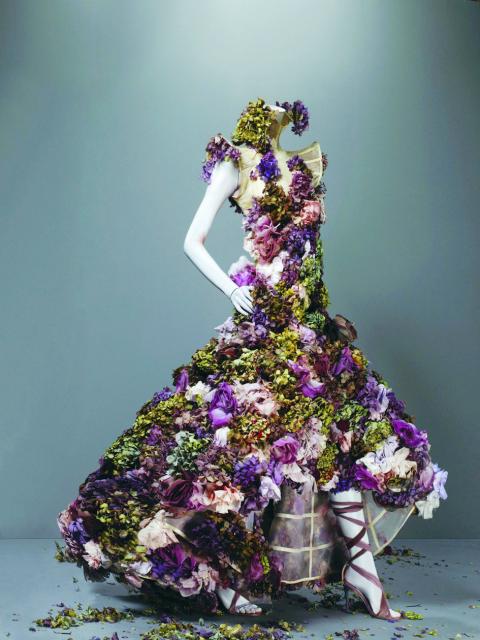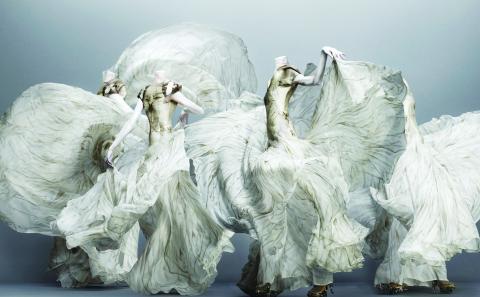A hairstylist friend of mine used to place leather bondage gear in her downtown shop window to scare off what she called “the wrong element,” meaning anyone wanting a nice wash and trim. She wanted to be sure that if you sat in her chair, you were ready to accept whatever look she decided on for you, because it would change the way you saw yourself in the world. That was the deal.
Alexander McQueen: Savage Beauty at the Metropolitan Museum of Art in New York, a survey of the career of the British fashion designer who died last year, a suicide at 40, is similarly about control and change. The show, or rather what’s in it, is a button-pushing marvel: ethereal and gross, graceful and utterly manipulative, and poised on a line where fashion turns into something else.
Part of its dynamic is old-fashioned shock. In galleries that combine the look of baronial halls and meat lockers, clothes come at you like electrical zaps: a blouse threaded with worms, a coat sprouting horns, shoes that devour feet. A pert little jacket is printed with a crucifixion scene; the hair on a full-length hair shirt is carefully waved and combed; a corset has a cast-metal animal spine curling out from behind.

Photo: Reuters
And everywhere there are arresting delicacies. The yellow-green beadwork is so fine it looks as soft as moss. Floral-patterned lace has been cut up, flower by flower, then stitched together again, but only partially, to give a dress the illusion of having being torn.
The details pull you back to the start of the show after your first wild ride through. And it’s on the second, slower look that some of the prickly contradictions that underlie McQueen’s work, and fashion as a genre, start to emerge.
McQueen grew up in London, the son of a cabdriver. He made much of his working-class Cockney roots. They were, along with his homosexuality and rebelliousness, part of his insider-outsider credentials, his wrong-element-wherever-I-am identity.

Photo: Reuters
At 16 he landed an apprenticeship with a Savile Row tailoring firm that catered to the British royal family, and he was a more than apt pupil. A virtuosic grasp of the mechanics of clothes making — cutting, sewing, constructing — became early hallmarks of his design, with drapery skills developing later. He was always a hands-on worker: in art terms, a formalist as much as a conceptualist.
But it was the conceptualist, the idea man, the storyteller, who began making news. After a stint with a theatrical costume company he went to design school and quickly gained a reputation for distinctively dark, louche brilliance. He titled his graduate show Jack the Ripper Stalks His Victims, signing each piece with a stitched-in lock of hair. He turned to violent films like Taxi Driver and The Shining for inspiration, and to tales of persecution (17th-century witch hunts) and martyrdom (Joan of Arc).
In 1994 he had some commercial success with designs for ultra-low-rise “bumster” pants that helped start an international trend. But he was still most interested in narratives, in making each new collection an attention-grabbing drama. One way to get noticed was by alienating people, and the runway show for his Highland Rape collection of 1995-1996 drew some serious heat.
He said that he meant the show as a commentary on England’s pillaging of Scotland, where he claimed ancestry. But the sight of zonked-out models stumbling around in torn dresses brought accusations that he was cashing in on abusive images of women. The bad-boy image, which was already part of his kit, intensified and stuck.
Still, he didn’t stay with any one theme for long, though the curator of the Met show, Andrew Bolton of the museum’s Costume Institute, tries to give the career an organic shape by viewing it through the lens of Romanticism. And he eases us into this view with an introductory gallery of quite wearable-looking jackets and dresses, with quasi-traditional tailoring and lines as clean and emphatic as if ink-drawn.
Beyond that point, however, drama heats up.
Clothes become costumes, with sensuous, sumptuous lives of their own.
What looks like Victorian funerary attire fills one end of a mirror-lined room: a black ensemble with a leather halter, a jet gown of billowing silk, and an awesome black-feathered body suit, pumped up as if it were about to explode.
By contrast, at the room’s other end, enshrined in a giant glass casket, there’s a lineup of light, bright ready-for-heaven wear: a gilded-feather coat with a skirt of white silk gushing out from below; a long gray robe printed with faces of angels at the shoulders.
The adjoining gallery, called a “Cabinet of Curiosities,” has a fancy gift-shop look, with McQueen-commissioned fashion accessories, among them an extravagant, butterfly hat by Philip Treacy and jewelry — the backboned corset, a silver crown of thorns — by Shaun Leane. Most interesting, though, are videos of the designer’s runway shows playing on monitors set high on the walls.
For someone who never saw the original productions — I didn’t — these are absorbing documents. In one video a model stands on a slowly revolving platform as two robotic machines aggressively spray her with paint. In another, a model staggers, bare breasted, down a catwalk into the face of an artificial blizzard as her kimonolike robe balloons out behind her. Just beyond this room is the installation of outfits from Highland Rape.
McQueen repeatedly said, as have many other designers before him, that his intention was to “empower women” through his designs, though the impression often is that he’s hobbling, even tormenting them. And while his insistence on political content is one of the more intriguing aspects of his work, it is also one of the slipperiest and least resolved.
The Highland Rape collection, with which he asserted a Scottish allegiance, was followed by another that was an unmistakable, if partly tongue-in-cheek, homage to British monarchy, with the two collections accompanied by volleys of nationalistic bluster. And although McQueen grumbled about racist stereotyping in Western fashion, he perpetuated such stereotypes in his Asian- and African-derived designs.
The Met exhibition passes all this off as manifestations of a Romantic temperament, but you have to ask critical questions. The chief problem with the fashion-as-art fad of the 1990s was precisely that it didn’t ask them.
To take two examples, for its 1997 exhibition The Warhol Look: Glamour Style Fashion, the Whitney Museum did little more than fill a floor with Warhol paintings, back issues of Interview and a Diana Vreeland tape and basically said: Let’s celebrate.
Two years later the Guggenheim — though it denies this — effectively rented its Manhattan premises to Giorgio Armani for his retrospective. (Such deals are now the norm, and the Met is forthright about stating that most of the money for the McQueen retrospective comes from the fashion house called Alexander McQueen.) My point is: If you’re going to deal with fashion as art, treat it as art, bring to it the distanced evaluative thinking, including social and political thinking, that scholars routinely apply to art.
Such an approach is standard in exhibition catalogs that accompany most Met shows, but not in the McQueen catalog, which, beautiful though it is, is heavy on pictures, skimpy on text.
To be fair, the show and the book were both assembled in record time during the year following McQueen’s shockingly sudden death. Suffice it to say that future researchers will want to take him out of the all-purpose tent of Romanticism and place him firmly in the cultural milieu he shared with artists like Damien Hirst, Matthew Barney and Leigh Bowery, not to mention Lady Gaga, with her cutlet couture.
And why not compare him, as a politically minded designer, with one from an earlier generation, Rudi Gernreich. They make an instructive pair. McQueen deserves this detailed accounting.
The Met show, designed by Sam Gainsbury and Joseph Bennett, is, I say again, a marvel. Among other pleasures, it has some of the most striking sculptures that I’ve seen in New York in years, from a pillar of ivory silk organza so thick with layers and folds that it looks out of focus to a spacesuit ensemble embroidered head to heel with iridescent spangles.
The platform boots that go with the suit are amazing. Curved like giant hooves, or like ballet slippers grotesquely frozen on point, they make an unforgettable sight, as sculpture should. They’re functionally cruel, formally perfect, conceptually wild. If you can walk in them at all, and apparently some people can, they have to change the way you move through the world.

May 18 to May 24 Pastor Yang Hsu’s (楊煦) congregation was shocked upon seeing the land he chose to build his orphanage. It was surrounded by mountains on three sides, and the only way to access it was to cross a river by foot. The soil was poor due to runoff, and large rocks strewn across the plot prevented much from growing. In addition, there was no running water or electricity. But it was all Yang could afford. He and his Indigenous Atayal wife Lin Feng-ying (林鳳英) had already been caring for 24 orphans in their home, and they were in

On May 2, Chinese Nationalist Party (KMT) Chairman Eric Chu (朱立倫), at a meeting in support of Taipei city councilors at party headquarters, compared President William Lai (賴清德) to Hitler. Chu claimed that unlike any other democracy worldwide in history, no other leader was rooting out opposing parties like Lai and the Democratic Progressive Party (DPP). That his statements are wildly inaccurate was not the point. It was a rallying cry, not a history lesson. This was intentional to provoke the international diplomatic community into a response, which was promptly provided. Both the German and Israeli offices issued statements on Facebook

Even by the standards of Ukraine’s International Legion, which comprises volunteers from over 55 countries, Han has an unusual backstory. Born in Taichung, he grew up in Costa Rica — then one of Taiwan’s diplomatic allies — where a relative worked for the embassy. After attending an American international high school in San Jose, Costa Rica’s capital, Han — who prefers to use only his given name for OPSEC (operations security) reasons — moved to the US in his teens. He attended Penn State University before returning to Taiwan to work in the semiconductor industry in Kaohsiung, where he

President William Lai (賴清德) yesterday delivered an address marking the first anniversary of his presidency. In the speech, Lai affirmed Taiwan’s global role in technology, trade and security. He announced economic and national security initiatives, and emphasized democratic values and cross-party cooperation. The following is the full text of his speech: Yesterday, outside of Beida Elementary School in New Taipei City’s Sanxia District (三峽), there was a major traffic accident that, sadly, claimed several lives and resulted in multiple injuries. The Executive Yuan immediately formed a task force, and last night I personally visited the victims in hospital. Central government agencies and the